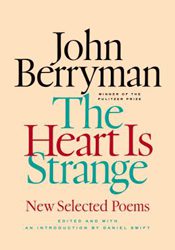
John Berryman’s The Heart Is Strange: New Selected Poems, edited and with an introduction by poet Daniel Swift encourages reevaluating Berryman’s reputation towards the future shaping of his lasting influence. Since Berryman’s death in the early 1970s his once near iconic rock-star poet status has faded but in his lifetime he garnered considerable popular acclaim as one of the great voices within American Poetry. Alongside his immediate peers Randall Jarrell, Delmore Schwartz and Robert Lowell, he was feted almost from the get-go as a rising young behemoth among the 1940s era scholar-poet New Criticism echelon. From the 1950s into the 1960s, and ever thereafter, along with Lowell, Sylvia Plath and Anne Sexton he became synonymously also known as a habitué of American Confessional poetry.
In 1964 77 Dream Songs, the initial volume of his colossal epic lyric poem-series The Dream Songs, won the Pulitzer prize while the later, significantly longer 1968 volume continuing the series His Toy, His Dream, His Rest won both the National Book Award and the Bollingen Prize. Berryman’s continually rising fame assuredly had its own ebb and flow of troubled times during which opportunities at one or another university always arose to save him. As Swift comments: “His life—it is not glamorous to say so—was a parade of grants and fellowships. When he was in trouble, the academic world came to rescue him.” Berryman was never to escape his own inner demons however and by 1972 he was gone. A suicide many see as a preordained elemental feature of his poetry.
The casual glance through Berryman’s work leaves the impression death was often on his mind. He recalls in the auto-biographical poem “The Heroes”: “I wrote mostly about death.” And the closing of his late poem “Henry’s Understanding” if read autobiographically appears leave little doubt where Berryman felt himself headed:
[…] it occurred to me
that one night, instead of warm pajamas,
I’d take off all my clothes
& cross the damp cold lawn & down the bluff
into the terrible water & walk forever
under it out toward the island.
Yet Berryman is no mere depressive full of exhibitionistic doom and gloom. Swift’s editorial selection and his introduction certainly at least in part challenge such a reading. While Berryman’s poems will always be tinged with more than a bit of flashy sensationalist bravado, slangy yet possessing classic decorum and contemporary reference: “Dog-tired, suisired, will now my body down / near Cedar Avenue in Minneap, / when my crime comes.” (“The Poet’s Final Instructions”) Swift offers contemporary and future readers a Berryman who may be seen as less self-absorbed than commonly thought and broadly engaged with not only literary matters of his day but major social and political events and figures as well.
Swift includes poems such as “Formal Elegy,” Berryman’s lengthy poem marking the assassination of JFK, along with “The Minnesota 8 and the Letter Writers,” in which Berryman enters into the public fray of a court case on behalf of American activists against the Vietnam War, and two previously uncollected poems: “The Cage” and “Mr Pou & The Alphabet.” The former pays homage to Ezra Pound byway of recounting the older poet’s descriptions of the U.S. military “cage” in which he was imprisoned in Italy on counts of treason at the end of WWII, which Berryman heard in person on visits to Pound while incarcerated at St. Elizabeth’s Hospital, while the latter written for the poet’s son is demonstrative of a more rarely witnessed light-hearted Berryman: “V is for vowels the Pou is to learn.”
An argument supporting Swift’s own in favor of reconsidering the public address of Berryman’s poetry is found in Philip Coleman’s new extensive study John Berryman’s Public Vision: Relocating the Scene of Disorder. Coleman is convincingly thorough, drawing upon works across Berryman’s entire oeuvre, including his criticism (Berryman authored a study of Stephen Crane and an unfinished study of Shakespeare—a lifelong passion) and his fiction (which consists of a couple semi-autobiographical stories and novel Recovery concerning his treatment for alcoholism). Coleman’s book contains numerous discussions of individual poems found in The Heart Is Strange, reinforcing the timeliness of its publication and the worthwhile selection of its contents:
“Berryman’s poetry demonstrates a degree of responsiveness to the world that undermines the charges of ‘solipsism’ and ‘non-engagement’ so often leveled against him […] Berryman’s poetry was construed and constructed by him as a way of understanding the world as he experienced it, from the start of his writing career in the 1930s through to his death in 1972. Again and again, poetry for Berryman represented a way of apprehending and understanding the ‘News of one day, one afternoon, one time’ as put it in the early poem ‘World-Telegram’ “
Turning to look at “World-Telegram” in The Heart Is Strange, Berryman is clearly relating a concern with the direction it appears the world may be headed and the position in which the United States and its people are thereby placed.
Berlin and Rome are having difficulty
With a new military pact. Some think
Russia is not too friendly towards London.
The British note is called inadequate.
He appends the actual date 11 May 1939 to the poem, as if saying to readers, go and look to see for yourselves what the headlines were that day. While the chatty rattling off of headlines and fragments of news stories running along through the stanzas has a rather surprising resemblance to one of Frank O’Hara’s “I do this/do that” poems, Berryman’s focus remains decidedly with that of a “public” rather than expressing concern over any ramifications these worldly events/situations may have upon his own personal life. In the closing stanza Berryman strikes a decidedly ironic stance, remarking “If it were possible to take these things / Quite seriously” there is no doubt it would “perfectly demoralize the nation.” This poem is one of many in which Berryman takes on the role of the public poet in which Swift’s selection and Coleman’s critical re-evaluation urge he be perceived.
Coleman also focuses a significant amount of his argument around “Formal Elegy” which is “perhaps the poet’s most obvious ‘public’ poem from the later part of his career but, apart from a handful of responses, it has received very little critical attention” and thereby demonstrates how “critical neglect of the poem has of course played a role in undermining its significance in the Berryman canon.” Reconsideration of “Formal Elegy” along with others such as “World-Telegram” or “The Minnesota 8 and the Letter Writers” will “redirect the trajectory of the poet’s career along very different routes of interpretation to those commonly assigned by the narrow confessional label.”
Both Coleman and Swift are of course well aware of the heavily romantically-tinged view of Berryman as an emotionally crippled and damaged poet which has been readily disseminated as his standard legacy to many writers and other artists. The epilogue of Coleman’s study “Holding with Berryman” discusses how there are a number of contemporary examples of writers drawing upon Berryman as an influence, perhaps best exemplified in Stephen Burt’s essay “My name is Henri: Contemporary Poets Discover John Berryman,” for many of whom he remains primarily a poet of failed personal ambition.
Meanwhile Swift’s introduction draws attention to the uses several contemporary rock bands have made of dropping nods to Berryman into their lyrics: “In ‘Mama, Won’t You Keep Them Castles in the Air and Burning?’ by the band Clap Your Hands Say Yeah, the singer intones joylessly, ‘I came softly, slowly / Banging me metal drum / Like Berryman.'” As terrific as having such “Pop” recognition occur for a poet may be, Berryman’s work deserves broadened sighting of its worthwhile relevance to interests beyond the morose and depressive confines of the confessional poet sub-genre. Coleman points out: “Berryman believed poetry was ‘one of the most useful tools we have for understanding human reality,’ as he put in his BBC interview with [A.] Alvarez in 1967.” And Berryman was clearly speaking from a perspective well beyond the confines of the personal.
Coleman and Swift both also make it clear how wide open previously unexplored nuances of Berryman’s influence are, regardless of wherever past scholarly trajectories may have placed him. Berryman’s playful exuberance, his mixing of past and present tenses, along with his vast idiomatic dexterity, moving between slang and formal modes of address within his lines, make him a candidate for influencing any number of poets formally considered outside the supposed range of academic interest. For years I’ve been keen on the idea of Berryman’s possible influence on poet Ted Berrigan’s work. As Berrigan was ever canny when he felt like it about the breadth of his interests and only exposed what he wished be made known about his abundant resources and influences, it can be pretty difficult at times to pin him down on such matters. Yet it’s not at all difficult to imagine Berrigan taking interest in the highly staunched challenging eclecticism found in just about any of the 8-line sections of Berryman’s Homage to Mistress Bradstreet:
19
So squeezed, wince you I scream? I love you & hate
off with you. Ages! Useless. Below my waits
he has me in Hell’s vise.
Stalling. He let go. Come back: brace
me somewhere. No. No. Yes! everything down
hardens I press with horrible joy down
my back cracks like a wrist
shame I am voiding oh behind it is too late
Berrigan’s increasingly acknowledged breakout masterpiece The Sonnets (1964) may in many ways be seen as his successful attempt at, among other things, outdoing Berryman at own his game by taking the poem to the street. The shuffling of “found” lines (those borrowed, stolen, or otherwise “lifted” from unnamed source material) and the high number of disparate references jumbled akimbo and scattered across the fourteen line (or often enough a few more) boxes of text found upon each page share much in common with Berryman’s work. Besides the sonnet after all was a form to which Berryman demonstrated he was more than a bit partial, despite its bad name among American Modernist poets such as William Carlos Williams. As Swift acknowledges:
“Williams instructed his generation:
‘don’t write sonnets. The line is dead, unsuited to the language. Everything that can ever be said from now until doomsday in the sonnet form has been better said in twelfth-century Italian.’
Berryman’ s whole career might be understood as a rebuke to this.”
Swift describes how Berryman’s earliest published works are sonnets and discusses how his mid-career poetic development hinges to some degree on a book of love sonnets written over the course of an extramarital affair in the fifties but not published until a decade later entitled Berryman’s Sonnets. The form of The Dream Songs may also be read as an ongoing extended-sonnet sequence. Swift also makes mention of comments by Adrienne Rich tying together Berryman and singer-songwriter Bob Dylan as displaying masterful understanding of the improvisatory nature of the American language, commenting how Dylan and Berryman “both created by theft, by allusion and borrowing.” The same description might easily fit Berrigan too, who directly offers “a rebuke” to Williams of his own in his sonnet “XV” referencing the same Williams quote, even if tongue-in-cheek:
and the sonnet is not dead.
takes the eye away from the gray words,
Diary. The black heart beside the fifteen pieces
Monroe died, so I went to a matinee B-movie
washed by Joe’s throbbing hands. “Today
What is in it is sixteen ripped pictures
does not point to William Carlos Williams.
Berrigan, much like Berryman, came early on to remaking the sonnet according to his own technique, often returning to the form on repeated occasion.
In addition to the rather matter-of-fact similarity of both poets writing sonnets, each pushing and probing the form in their own unique way, the two poets also developed a highly stylized manner of personal presentation. Each became highly aware of themselves as The Poet: a role to be developed and maintained, expanded upon from the material out of which their poems were written. In his 1970 collection Love & Fame Berryman recalls the feeling he had as a young would-be poet, searching for his own set of poetic mannerism:
I didn’t want my next poem to be exactly like Yeats
or exactly like Auden
since in that case where the hell was I?
but what instead did I want it to sound like?
(“Two Organs”)
Nonetheless Berryman did go so far as adopting an English manner of speech and exploiting his persona as the poet-professor. Swift comments how “…the universities gave Berryman a role to play and to play against.” (xxv) Similarly, Berrigan quickly found a hip poet persona on the streets of the Lower East Side and never lost his sixties-era bohemian aura which he likewise found as just a useful front to dislodge audience expectation and set himself apart.
Berrigan however seems to have pretty easily slipped into his persona and never suffered any of the conflicted inner tensions over the poet role which increasingly haunted Berryman for whom there was never to be a comfortable existence. By the time of Berryman’s late poems the character “Henry” who originally appeared in The Dream Songs is an ever thinningly-veiled autobiographical narrator:
A human personality, that’s impossible.
The lines of nature & of will, that’s impossible.
I give up the whole thing.
Only there resides a living voice
which if we can make we make it out of choice
not giving the whole thing up.
(“I’m reading my book backwards…” Henry’s Fate & Other Poems)
The new selected Berryman arrives in celebration of 2014 as the poet’s centennial birth-year. His publisher Farrar Strauss & Giroux (FSG) has also released new editions of 77 Dream Songs, The Dream Songs, and Berryman’s Sonnets. The latter is far from a major work yet as already mentioned is nonetheless quite demonstrative of a poetic transition Berryman undertook within his work leading into The Dream Songs. Whereas excluding selections of The Dream Songs from The Heart Is Strange is perfectly reasonable, not excerpting or even better including in total Berryman’s Sonnets seems rather odd. FSG unfortunately comes across as more interested in potential book sales over the virtues of an adequately edited text to serve as introduction to Berryman’s oeuvre.
This is not to mention what’s desperately needed: a complete authoritative edition of Berryman’s Collected Poems (excluding The Dream Songs), Charles Thornbury’s previous edition comes close but leaves out the posthumously edited and published Henry’s Fate & Other Poems, which The Heart Is Strange does excerpt from. This last volume lies in a rather awkward state as it was gathered together and edited without Berryman’s approval. Making its case even stranger is the fact that it presents what appear clearly to be further Dream Songs. Berryman had plenty of loose ends in life, and in death so far they only continue.






